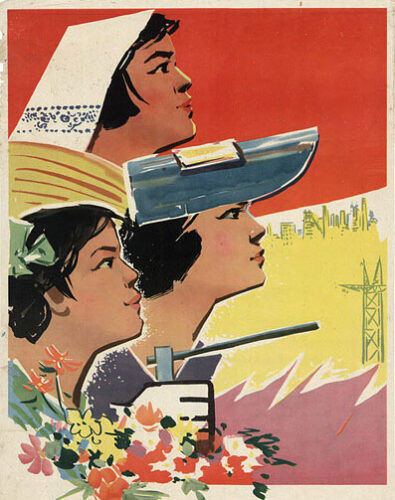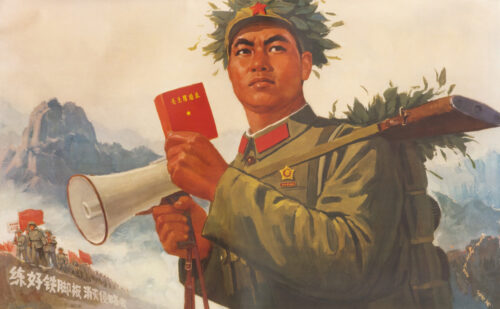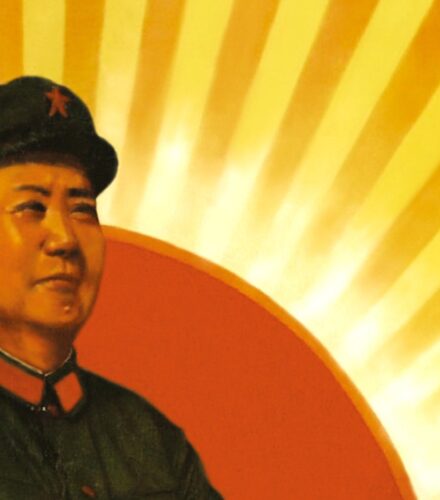‘China After Mao’: Frank Dikötter plays the old hits in new book
Frank Dikötter has made a career out of castigating the Chinese Communist Party and its leadership, starting from Mao Zedong. He remains unrelenting in his new book, "China After Mao," which covers the period of China's recovery and rise.

The People’s Trilogy, a set of three books by Dutch historian Frank Dikötter — on the 1949 revolution and initial years of Communist rule, the Great Famine of 1959-1962, and the Cultural Revolution — achieved considerable commercial success. There is no doubt that the books are great works of archival exploration and explication, shining a light on some of the darkest periods in Chinese history; at several points during Mao’s Great Famine, I literally had to put the book down, overwhelmed by the human suffering he documents. They are essential reading for anyone interested in understanding contemporary Chinese society, and help you understand the deep scars and fierce passions which make China what it is today.
Yet historians were rather more skeptical. There have long been suggestions that Dikötter’s scholarly rigor is lacking, and that his books have a discernible political agenda. So it is that his latest volume — China After Mao — this time concerning more recent Chinese history from Huá Guófēng 华国锋 to the ascent of Xí Jìnpíng 习近平, has been met with mixed reactions.
Nonetheless, I was excited by this new Dikötter work. What would he say about China’s economic take-off, and what dark secrets might he have uncovered?
~
By 1976, when Máo Zédōng 毛泽东 died, China was in a state of near collapse, its economy requiring military labor to keep operating, its GDP per capita ($165) lower than nations in sub-Saharan Africa, its education in disarray, its diplomacy — despite Nixon’s famous visit of 1972 — barely extant. This is the context in which Dikötter begins his survey of China, taking the reader from the death of Mao (and the other portents of that year, like the Tangshan earthquake) up until the elevation of Xi Jinping as the fifth paramount leader since Mao.
He thus takes the reader through the leaderships of Huá Guófēng 华国锋, Dèng Xiǎopíng 邓小平, Jiāng Zémín 江泽民, and Hú Jǐntāo 胡锦涛. His focus is largely on the leaders and their economic policies, though he is careful to give contextualizing details to reflect the reality of the regular people. In a sense, then, after three books detailing the grimly spectacular failings of the Party’s leadership and the extent to which they abused China’s vast population, this book could have charted China’s rise, the success of the reform and opening up policies (inaugurated by Hua as well as Deng), its diplomatic successes, such as the return of Hong Kong in 1997, its accession into the World Trade Organization in 1999, and the Beijing Olympics of 2008. Perhaps it’s nostalgia talking, but the early 2000s did feel different: there was an optimism, an openness, the sense that anything was possible. For sure, corruption was everywhere, from Bó Xīlái 薄熙来 to Guō Měiměi 郭美美 to prostitutes operating openly in hotels (I tell newcomers that Beijing then reminds me of the sleazy New York depicted in Taxi Driver, and they don’t believe me). But so it was in the Gilded Age United States, or even Regency Britain when the Industrial Revolution took off and made fortunes for a hungry new middle class.
But this is not Dikötter’s intention. His goal is not to celebrate, or even enlighten. His aim is to castigate the Communist Party and its leadership, and to demonstrate their moral, ethical, and political failings. Of course, there were many of these during those turbulent years, not least the leadership’s near-death experience during the Tiananmen Square protests and savage crackdown. But Dikötter signally fails to give any credit at all. He comes not to praise Deng, Jiang, and Hu, but to bury them.
One of Dikötter’s recurring strategies is to describe a general situation using statistics and archival data, and then end the paragraph with one or two concrete examples. This worked to great effect in his books on the Great Famine and the Cultural Revolution, where the mere fact of these events having occurred at all is a cruel testimonial to the horrific periods he is describing. For instance:
Torture was rampant. Iron wire was used to pierce the ears of “bad elements,” while women were stripped and suspended by their hair. In the words of a leader in Jieshou county, “their breasts were twisted until liquid oozed out.” In Linquan, the use of violence was summarized as follows by the local party boss: “People died in tragic circumstances, being beaten and hanged to death, deprived of food or buried alive. Some were severely tortured and beaten, having their ears chopped off, their noses dug out, their mouths torn off, and so on, which often caused death. We discovered how extremely serious all of this was once we started investigating.” Murder was common. In Dahuangzhuang, a small village in Linquan, nine out of nineteen cadres had killed at least one villager during the famine. Li Fengying, a team leader, killed five people.
It is impossible to quantify horrific abuses like this, especially in China, where no one knows anything, but the fact of them occurring at all demonstrates the nature of the period.
But this strategy is not as effective when it comes to economic policy, upon which Dikötter regularly upbraids the Chinese leadership. For example, regarding banking problems:
Procurement stations could no longer turn to the Bank of Agriculture, making the problem yet more acute. Under constant pressure from local authorities, branches of the bank had extended loans so liberally that they had reached rock bottom. The state bank responsible for agriculture was effectively bankrupt […] In Jingzhou, Hubei province, some 40,000 cadres owed an average of 1,000 yuan each, the equivalent of two years’ pay for an average worker. “And what do they do with the money? They do business, they build a house, they buy luxury goods, they pay for a wedding, some even use it to gamble,” the bank representative clarified. To bypass the lack of funds, farmers were issued IOUs. In Yueqing county, roughly half of all deposits in the 131 branches of the Bank of Agriculture were promissory notes.
But unlike the deaths or abuses in his previous books, economic problems occurring in villages or counties need not be systemic. They indicate problems, for sure, but we do not know how prevalent they were. They are concrete examples, but they illustrate little more than China struggling to adapt to a market economy — “feeling the stones,” as it were.
It’s not that China After Mao is riddled with errors (although there are a few, such as when he says that Orwell’s Animal Farm was banned after 2014, when it’s still freely available across the nation), or that Dikötter’s reading of CCP politics is so wrong-headed. He conveys the ins and outs of the top-level leadership with great clarity. But China After Mao is unfortunately deeply partial.
So, amongst the economic data, there is much talk of the rapid expansion of the monetary base, but few accounts of increasing household wealth, especially in the seaboard provinces. There is no discussion of increasing ownership of consumer goods and the gradual opening of media freedoms. There is no account of the Party’s withdrawal from private life during the 1980s, allowing, for instance, individuals to marry without requiring state dispensation. There is no account of Zhū Róngjī’s 朱镕基 selling-off of the state-owned properties in the late-1990s that accounts for so much urban household wealth. There is no great examination of the Special Economic Zones set up first in Shenzhen and then throughout the nation. This is a pity, as people aren’t stupid and their willingness to move there suggests it must have been superior to rural life. How was this so?
Another key thesis in China After Mao is the extent to which the Party was determined to maintain political control, even (or especially) as economic controls were lifted. Frequently he quotes leaders, from Deng to Hú Yàobāng 胡耀邦 to Zhào Zǐyáng 赵紫阳, emphasizing political ruthlessness and the necessity of control. (For instance, Zhao Ziyang said China must “oppose and resist bourgeois liberalization, oppose and resist capitalism, feudalism and other ideologically corrosive influences.”) The idea, fashionable in the 1990s, that economic openness would bring political reform meant Western leaders kept closing their eyes to all available evidence. But it would have been useful to discuss more fully what Chinese leaders were saying on “democratic reform” — Wēn Jiābǎo’s 温家宝 speeches often cited this — and to consider whether this was genuine bad faith.
The chapter on the Tiananmen protests and subsequent crackdown in 1989 will probably receive the greatest attention. Here, I think, Dikötter’s strengths as a historian come to the fore: he describes the steps toward tragedy with a sense of doom, and moves ably from the government leadership to students to industrial workers (whose joining of the protests the government feared greatly). He likewise demonstrates how nationwide the protests were, describing scenes in Lanzhou and Xinjiang as well as better known ones in Tianjin and Shanghai. More grimly, he captures not just the bloody climax at the start of June but the long counter-strike against the propaganda campaigns that seem to be finding their fullest expression under current people like Zhào Lìjiān 赵立坚 and Sīmǎ Nán 司马南 (the zealous blogger who recently apologized for having bought a home in the U.S).
If Tiananmen brought an end to the hopes of a democratic China, its subsequent propaganda campaigns have led to another ending — the closure of the Chinese mind, and the relentless aggression toward all who dare question the Party. Such “Wolf Warrior Diplomacy” is of course a hallmark of Xi Jinping, but its roots may well start in 1989. Yet if the current economic downturn continues, it would be no surprise to see the Chinese leadership expressing greater emollience. But while Dikötter does well to trace these twists and turns of recent history, he does so with enmity rather than empathy. Ultimately, China After Mao aims to prove the inadequacies of Communist rule, rather than reflect on the conflicts, limitations, and historical contingencies of the period.






